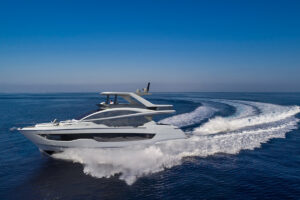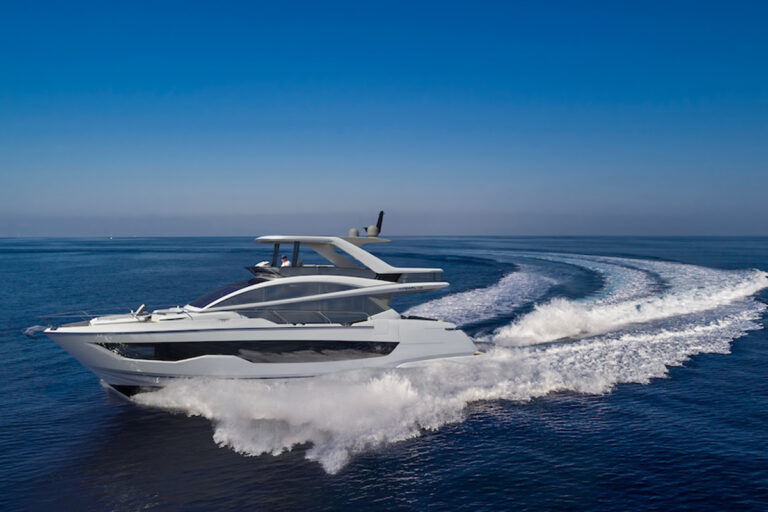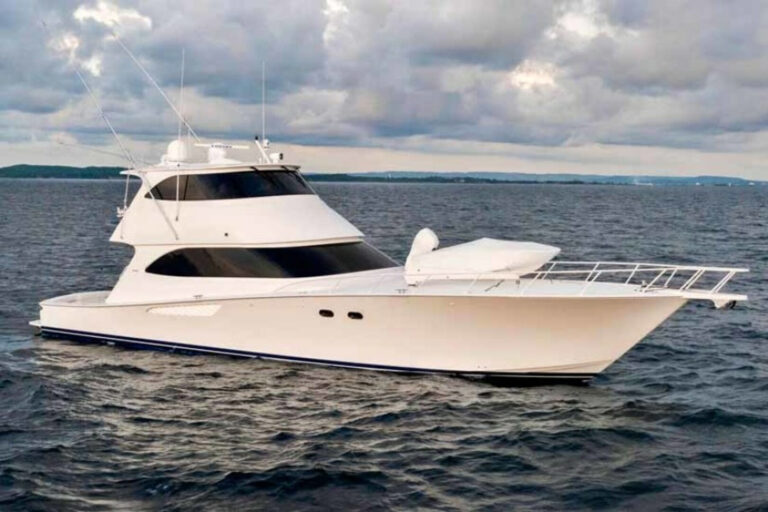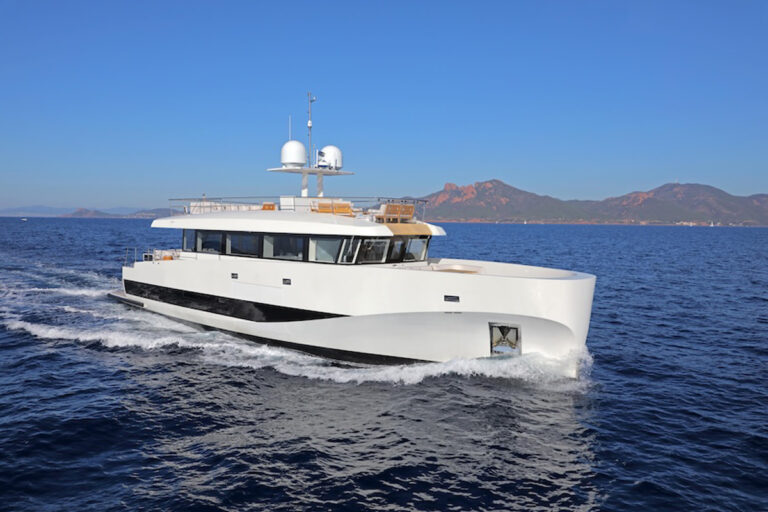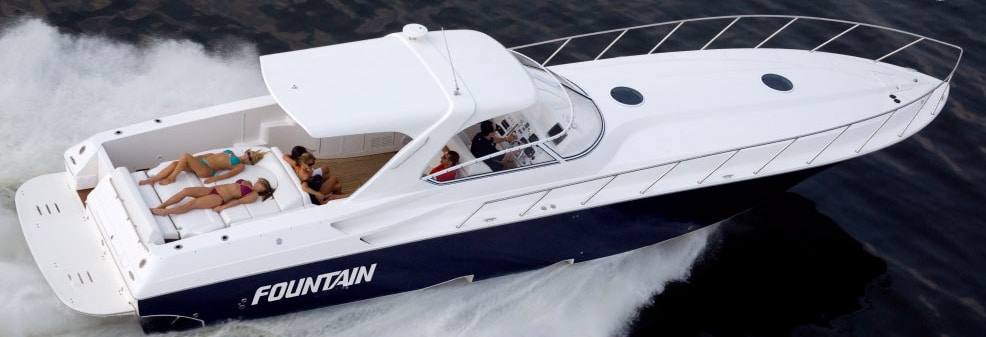
Fountain 48 express cruiser
The new Fountain 48 Express Cruiser, with triple Yanmar diesels totaling 1,260 hp, is capable of speeds approaching 57 knots. Outfitted with Mercury engines that deliver another 240 horses, the boat tops out around 61 knots, according to Fountain Powerboats President and CEO Reggie Fountain.
Fountain’s three decades of racing accolades are impressive, but the important question is this: At such speeds, is this boat safe and suitable for its intended purpose, that of a family cruiser?
The short answer is yes.
I’ve driven a lot of boats, including a few that were faster, but double-stepped hulls with Arneson surface drives are not my strong suit. Getting surface drive boats onto plane often takes a bit of finesse with the throttles and drive angles. Stepped hulls can be unpredictable in turns.
Our test boat exhibited neither of these peculiarities, which, according to Fountain, come from problems with achieving and maintaining ventilation of the steps and surface propellers. Getting air to them is the key.
From the keel outward, the step on a Fountain hull is angled forward and the cavity widens slightly. Abaft the step, the bottom is raised and carries a buttock angle slightly steeper than forward of the step. The general configuration was refined with each generation of boats, but Fountain still builds a prototype to test the exact dimensions for each new model, including the 48 EC.
At the transom, each propeller is fitted with a large tube that draws air from the surface to a point just above the prop hub. This ventilates the top half of the propeller, allowing it to spin up and get the boat on plane faster. Once the water breaks away from the transom, the tube rides clear of the water to avoid unnecessary drag.
As we headed downriver from the Fountain factory, past the point where the Tar River becomes the Pamlico, a couple more operational concerns became apparent. First was the need to keep a constant eye ahead, as the navigation markers passed with unaccustomed frequency. The second was avoiding flocks of seabirds, whose speed in flight was less than ours.
The Rolla propellers originally fitted on our test boat had been removed to complete another boat being delivered the previous day, so we did some prop testing along with our sea trial. We topped out about 56 knots, a bit less than with the Rollas, according to Fountain. More impressive and important to family buyers, the cruise speed was 52 knots with the Yanmars loafing at their continuous duty rating of 3000 rpm.
Our test boat was so steady across the open water, her windshield so protective, that a Gaffrig log reading from the Simrad GPS was the only way to judge our speed. The Yanmar diesels are quite smooth and quiet, and the props are well abaft the hull at the end of the Arneson drives, so there was little vibration anywhere on the boat.
Noise at the helm was minimal; the only rattle came from a loose fitting on the half-bimini that extended forward from the radar arch. This minor problem, which most builders would have ignored, was quickly corrected when we returned to the factory dock to change props for a second run.
That the company’s chairman would give attention to such a detail speaks volumes about the man’s obsession with the boats that bear his name. During a factory tour, I asked Gary Baltz, Fountain’s marketing specialist, about the process for developing a new model such as the 48 EC.
“Reggie is our focus group, he said.
Fountain has a design and engineering department, of course, but the experience gained by Reggie Fountain’s years of personally developing, racing and refining boats is apparent. Hulls are all vinylester construction, reinforced with alternating layers of mat and quadraxial stitched roving. These are handlaid, then squeegeed to ensure a light, strong laminate.
Vacuum-assist is used to prevent pre-release, a problem that occurs when a hull pulls away from the mold prematurely during construction. Pre-release can create a discontinuity in the hull’s lines, which results in erratic performance at speed.
Fountain further ensures a fair hull by blueprinting each boat before it leaves the plant. According to Baltz, the standards are so strict that almost every boat requires some rework of its hull bottom to remove minor distortions. Every boat must pass a checklist inside the plant and is then water-tested, except boats shipped without engines.
“We try to get the boat as close to perfect as possible before the customer gets his hands on it, Baltz said.
The Fountain facility is ISO 9001 certified to ensure consistency of its procedures and products, but the standards set by Reggie Fountain are more defining. He has vertically integrated the production process as much as possible to achieve the quality he wants. All metalwork is done in-house, including fabrication of aluminum fuel tanks, stretch bending of windshield frames, and forming of deck rails. Wiring harnesses and steering systems are assembled on site.
While Fountain’s emphasis is on speed, creature comforts are not overlooked aboard the 48 EC. Accommodations forward include a spacious saloon/galley area and two cabins with queen berths. The forward cabin has a cedar-lined hanging locker. There are two heads with shower pans; both are fully lined with gelcoated fiberglass.
Headroom is 6 feet, 8 inches in most areas, except the after cabin, which is tucked under the helm. The accommodations are finished in attractive light upholstery with cherry cabinetry and accent panels. Two circular hatches provide light, air and emergency egress.
The galley is compact but complete. A two-burner ceramic cooktop and a Panasonic microwave handle cooking chores. There is also a Tundra refrigerator/freezer, and outside in a cockpit cabinet, a U-Line ice maker.
In the interest of safety, all corners in the accommodations are rounded, padded or both. As well behaved as the 48 EC is, there will be times when the boat takes an unexpected lurch at sea. With speeds north of a mile a minute, injuries could be severe if sharp corners existed.
On deck, two chairs at the helm have powered seats that drop to form bolsters. Two settees, one forward and one abaft the sunpad, provide additional seating. The top of the sunpad lifts to reveal a large stowage tub, and the entire assembly can be raised with an electric lift for unrestricted access to the three engines.
Access to and from the foredeck is easy, via narrow side decks with well-placed handrails and nonslip molded into the gelcoat. The fin that divides the air intake forms an access step, and a bit of nonslip here would help.
Aft, a wide transom platform covers the Arneson drives. There is a retractable shower here, with hot and cold water. Pop-up cleats are used in place of exposed ones, to avoid a trip hazard.
Contact: Fountain Powerboats, (252) 975-2000; sales@fountainpowerboats.com; www.fountainpowerboats.com.



